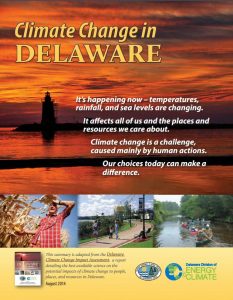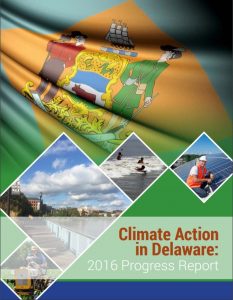
Climate change is happening now and it affects our everyday lives. We are seeing increased frequency and strength of coastal storms. Rainfall events are becoming more severe. Heat waves are affecting human health and our valuable agricultural sector. And, as a coastal state, we must pay attention to changes in sea levels.
Human activity affects climate change. The decisions we make today about how we manage our natural resources, and how we conduct our modern industrial activities, will affect our lives and the lives of our descendants.
We can plan to reduce the effects of human activity on climate change. We can prepare for the effects of the changes in our climate. And we can take action, both as a society and as individuals, in response to climate change.
Governor John Carney has released Delaware’s Climate Action Plan. The main goals of the plan are to reduce greenhouse gas emissions and to better prepare for the impacts of climate change by prioritizing clean energy and improved energy efficiency, providing support to state agencies in resilience efforts and increasing research and monitoring.
 The first step in managing climate change is understanding what it is, how and why it occurs, and what we can do to manage and adapt to climate change. For the global perspective, and more information about climate change science, we depend on NASA’s Global Climate Change site. At a more local level, the Division of Climate, Coastal and Energy website provides tools for understanding climate change and ideas for adapting to it. The Delaware Climate Change Impact Assessment is a comprehensive report that summarizes the best-available scientific information on the issue and presents guidance for Delaware residents, communities, and business to prepare for, adapt to, and act to reduce the effects of climate change. A 12-page summary of the report includes the findings of the Assessment, resources for more information, and contact information.
The first step in managing climate change is understanding what it is, how and why it occurs, and what we can do to manage and adapt to climate change. For the global perspective, and more information about climate change science, we depend on NASA’s Global Climate Change site. At a more local level, the Division of Climate, Coastal and Energy website provides tools for understanding climate change and ideas for adapting to it. The Delaware Climate Change Impact Assessment is a comprehensive report that summarizes the best-available scientific information on the issue and presents guidance for Delaware residents, communities, and business to prepare for, adapt to, and act to reduce the effects of climate change. A 12-page summary of the report includes the findings of the Assessment, resources for more information, and contact information.
Other educational resources:
Watch the Climate Change in Delaware video on YouTube
The Delaware Sea Level Rise Vulnerability Assessment
The Delaware Climate Projections Portal
 Executive Order 41 directed all Delaware state agencies to take action to reduce the greenhouse gas emissions that affect climate change, to increase the state’s resilience to climate change impacts, and to avoid and minimize the risks of flooding due to climate change. The Cabinet Committee on Climate and Resiliency created by that Order developed a Climate Framework for Delaware to present information on work by state agencies so far and to summarize the recommendations of working groups on mitigation, adaptation, and flood avoidance. The Climate Action in Delaware 2016 Progress Report presents an update on progress on these issues.
Executive Order 41 directed all Delaware state agencies to take action to reduce the greenhouse gas emissions that affect climate change, to increase the state’s resilience to climate change impacts, and to avoid and minimize the risks of flooding due to climate change. The Cabinet Committee on Climate and Resiliency created by that Order developed a Climate Framework for Delaware to present information on work by state agencies so far and to summarize the recommendations of working groups on mitigation, adaptation, and flood avoidance. The Climate Action in Delaware 2016 Progress Report presents an update on progress on these issues.
The single most important thing that individuals and households can do is to use less energy and make the energy you do use as “green” as possible:
Learn how you can take advantage of solar, geothermal and other green energy alternatives
Use less energy at home by weatherizing your home
See how Delaware’s modern building energy codes are helping reduce energy use
Reduce, re-use and recycle to save energy expended on waste management
Explore the potential of home- and community level green infrastructure
Learn about Delaware’s Clean Fuel and Transportation Initiatives
Reduce your contribution to greenhouse gas emissions by taking advantage of Delaware’s trails and greenways to walk and bike rather than drive, or take Delaware’s public transportation (DART First State)
 The changing climate is affecting how we live our everyday lives. We’re seeing increased frequency and strength in storm events. Heat waves last longer. Coastal flooding and erosion are always an issue for our coastal communities. The Cabinet Committee on Climate and Resiliency has prepared a guide for state agencies to guide their efforts — Avoiding and Minimizing Risk of Flood Damage to State Assets.
The changing climate is affecting how we live our everyday lives. We’re seeing increased frequency and strength in storm events. Heat waves last longer. Coastal flooding and erosion are always an issue for our coastal communities. The Cabinet Committee on Climate and Resiliency has prepared a guide for state agencies to guide their efforts — Avoiding and Minimizing Risk of Flood Damage to State Assets.
Local governments can use a collection of map-based planning tools, including the Delaware Sea Level Rise Inundation Map, federal flood-risk maps (FEMA), and a collection of geospatial data resources provided by Delaware FirstMap.
Other adaptation resources:
Learn more about wetlands, which help protect us from flooding
Explore the benefits of using natural systems (green infrastructure) in urban, rural and coastal settings
For more information about clean energy and climate issues, contact the Division of Climate, Coastal and Energy: 302-735-3480
For more information about air pollution and its effects, contact the Division of Air Quality: 302-739-9402
For more information about Delaware’s coastal lands, sea-level rise, and coastal processes, contact Delaware Coastal Programs: 302-739-9283
Regulations for State Energy Conservation Code (7 DE Admin. Code 2101)
Regulations for the Green Energy Program (7 DE Admin. Code 2103)
Environmental Standards for Eligible Energy Resources (7 DE Admin. Code 2104)
Air Regulations (7 DE Admin. Code 1100)
Related Topics: air, climate change, coast, global warming, green infrastructure, ocean, sea level rise, topic